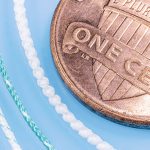14 Feb Engineer Spotlight: Cortland Biomedical’s Michelle Lishner Discusses Low-Density Braiding Capabilities
Cortland Biomedical Lead Development Engineer Michelle Lishner Discusses Why Low-Density Braiding is Well-Suited for Delivery System Components and Custom Sutures for Soft Tissue Assemblies
 Can you walk us through the low-density braiding process in your own words?
Can you walk us through the low-density braiding process in your own words?
The low-density braiding process can be broken down into four main steps: yarn preparation, winding, braiding, and rewinding. Yarn preparation includes twisting or plying yarn, which allows for yarn customization to achieve unique sizes and desired mechanical properties (for example, increasing twist to increase elongation). Yarn is then wound onto a bobbin, a small structure compatible with the braider for yarn pay-off. Once bobbins are loaded, braiding can begin. Low density braids typically are composed of between four and sixteen yarns in total. Once the braid has been manufactured to customer specifications, continuous braid lengths will be transferred onto a spool for final packaging or further processing, such as suture tipping. When developing low-density braided sutures, additional enhancements, such as custom suture colors or tracer yarns, can be added to improve suture management in soft tissue assemblies.
Cortland Biomedical can work with a wide range of high-performance raw materials, including Ultra-High Molecular Weight Polyethylene (UHMWPE), polyester (PET), aramids and resorbable material. With a variety of material options available, biomedical textile engineers can add value for medical device OEM customers by providing guidance towards the optimal selection for the specific clinical application.
What sets Cortland Biomedical’s low-density braiding capabilities apart from other companies?
 Cortland Biomedical’s low-density braiders are state-of-the-art – complete with an electronic interface, core and axial yarn configuration features, and medical-grade contact surfaces. Electronic braiders are ideal for rapid prototyping, as they allow for quick, software-driven iterations of various braid designs instead of relying on manual gears. Additionally, electronic braiders can create localized zones of braid density, including smooth transitions from high density stiff areas to lower density flexible zones.
Cortland Biomedical’s low-density braiders are state-of-the-art – complete with an electronic interface, core and axial yarn configuration features, and medical-grade contact surfaces. Electronic braiders are ideal for rapid prototyping, as they allow for quick, software-driven iterations of various braid designs instead of relying on manual gears. Additionally, electronic braiders can create localized zones of braid density, including smooth transitions from high density stiff areas to lower density flexible zones.
The addition of core and axials can further customize a braid by altering the braid cross section and mechanical performance. “Axials” are yarns that periodically travel between the lumen and outside of a braid wall. Incorporating axial fibers into a braid design can be utilized to introduce additional strength members, increase stiffness, and alter the surface texture of a braid. An example of this is the white braid on the far right of the image below. Alternatively, a core runs inside the lumen of the braid. Cores can be single or plied fibers, wires, monofilament fibers, or even low-density braids themselves. Both axials and cores can be used to manipulate the cross-section of a braid. The introduction of two axials/cores creates a flatter/ovular cross-section, while three axials/cores create a triangular cross-section, and four axials results in a rectangular cross-section. In contrast, one core allows the braid to maintain a circular cross-section, which can be helpful for applications where a braid must conserve a round profile to minimize flattening against a tight radius.
In addition to custom low-density braid design solutions, Cortland Biomedical offers specialized fabrication services for continuous loops, splices, multi-loop terminations, and manually-threaded suture assemblies. Renowned loop creation and splicing techniques have been inherited from the industrial branch of Cortland Company, which has been splicing high- performance industrial ropes for decades.
What types of products/applications is low-density braiding best suited for and why?
Low-density braiding is well-suited for sutures, tethers, cords, or pull wires, which are used in delivery systems for minimally invasive surgeries, transcatheter procedures, and robotics. Braids can withstand tortuous paths that are often found inside of devices due to their ability to maintain performance around small radii, which metal wires often fatigue around due to stress concentrations. The flexibility and high-performance nature of braids lends itself to surgical robotic applications, where braided solutions can offer a cost-effective replacement for single-use wires. Another area where low-density braids are ideal is for custom sutures for orthopedic soft tissue assemblies.
How do tension controls enable you to work with a more diverse range of materials – from the finest performance fibers to large diameter surgical grade wires?
Tension control is critical for textiles. Cortland Biomedical’s low density braiders are suited with modern tensioning systems, which are configured to handle a wide range of materials and sizes – from fine, delicate materials to bulky yarns and wires. All yarns in Cortland Biomedical braid constructs are individually tensioned, which allows braids to have a blend of materials or varying tensions to achieve different mechanical or surface properties. For example, using different tension on alternating yarns to create a textured surface (which is ideal for promoting tissue ingrowth).


